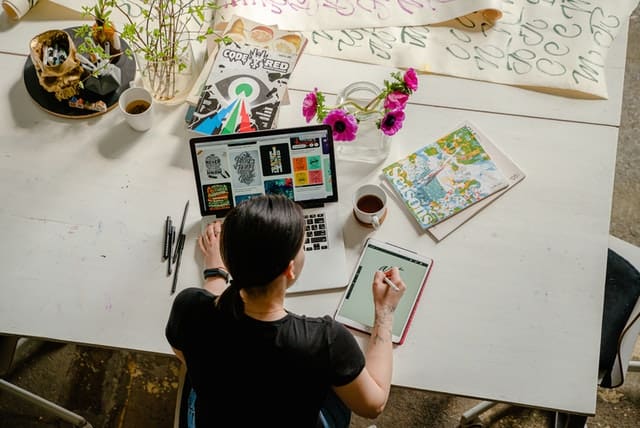Inspiration for artwork can be drawn from various different outlets. The past eighteen months has been a whirlwind of change, drama, turmoil, joy, and success. With all of these new events occurring in our lives, artists are beginning to express their thoughts and opinions through various works and mediums. When seeing this, we ask ourselves how we can take an event or emotion and turn it visual? Today, I will be discussing what principles and rules taught in art school help artists visualize their beliefs, as well as what outlets artists draw inspiration from to create their work.
What Are Artists Taught In Art School To Help Them Articulate Their Themes In Their Work?
I have been enrolled in the Apparel And Textile Design Program at Michigan State for over two years now. Though our assignments have been rather unorthodox ( I once had to create a monster that embodied a time in my life when I experienced two dynamic emotions). I learned many ways to articulate our theme through various disciplines. Here are some teachings that I have found useful.
Principles of Art
The Principles of Art represent how the artist uses elements of art to create an effect and to help convey the artist’s intent. There are 7 principles that apply; balance, contrast, emphasis, movement, pattern, rhythm, and unity/ variety.
I practiced this in my previous dress design in my Pattern Making course at Michigan State. I created tension and contrast in my work through incorporating dynamic design details. As you can see, the silver detail on my croquis sketch creates an imbalance in my dress. The difference in color and texture creates a dynamic contrast and emphasis on my designs. These features can either contribute to your overall theme, or add in a unique detail to help your garment stand out.
Elements of Art
The Elements of Art are described as the stylistic features that are included within an art piece to help the artist communicate their idea. There are seven elements; line, shape, texture, form, space, color, and value. These elements are basic forms included in every art form, and help bring out the most charismatic pieces in art. I use these in multiple steps of the design process when designing and constructing a garment. I use elements of line, value, space, and shape in my croquis sketches. These elements help my croquis look human-like, and my clothing designs realistic and artistic. The use of form, texture, space, and color is the circumference of all of my garments. The way I construct the garment to fit the shape of the customer, the textures and space I use to give it definition. These elements are important to keep in mind throughout the design process to create unique and creative garments.
Use Of Color
Color is in my opinion the strongest element of expression in dress. Color can manipulate the emotions of the viewer, or display the mood of your theme. We use color in our day to day lives. We wear black to a funeral to express mourning and dismay. We wear white on baptism days to express innocence, purity, and new beginnings. Color has a very powerful effect on how you want your client or viewer to experience wearing or seeing your garment.
Color can also be used when you go to market your garment as well. Background color, accessory color, etc… can all create a mood to attract your potential customers. Pastels reflect a youthful and almost child-like idea. Red portrays a sexy and sophisticated demeanor. All colors can be used to better define or reflect your theme in your clothes, and create your intended version of an ideal emotion in your viewer.
Critique
Critique is one of the more important parts of the design and creation process in any form of art. Having a fellow co-worker review your work with fresh eyes and provide you with their feedback can help better your work. The best way to do this is in a group setting. After explaining your theme, begin by describing different elements of your design to your co-workers. Ask your co workers for any positive feedback they can give, or what area of your design can be improved. We did this in my pattern design course. After making any croquis sketch or garment, we would present it to our class, as well as explain our theme and how we articulated it in our garment.
Though you do not always have to take a person’s advice, it is important that you receive critiques in a respectable way. Do not retaliate by saying rude and hurtful comments back to your critique, no matter how hurtful their comments were to you. With that, be mindful of how you give critiques on other people’s work. Give constructive criticism that will help improve the overall quality of someone’s work or how to better articulate their theme.
These rules of art and critique are at the foundation of any art courses at a professional level. We learn these rules so that we can move with or against them in our art to better communicate what we would like to share through our piece. Most forms of art are a silent way to express our thoughts and ideas. These principles and elements taught to us help us say these things in our creations.
Where Do Artists Draw Inspiration From To Create Art?
Artists are inspired through many outlets in their life. From events or emotions, opinions to objects, inspiration can be found anywhere. Here are some more common examples.
Nature
Nature has been an influential theme throughout the history of art. From painters such as Van Gogh to designers such as Olivia Malone are inspired by nature. We see this in fashion in many different outlets. In my previous project, I was inspired by waterways throughout the East Lansing area. I articulated this by incorporating a blue-themed color palette in my design, and used lightweight silk and chiffon fabrics that had a flow and hand that mimicked water movement. Nature has been found to influence color palettes, prints, fabrics, and cuts of a garment.
Politics\Current Events
Throughout the past eighteen months, the entire world has experienced a shift in how we go about our day to day lives. With the world-wide coronavirus shut-down, political turmoil in the United States, it has aroused emotional distress in many individuals. In order to cope with these difficult feelings, artists will create work to express their grief.
For Example, El Cadejo, created by German artist Mayra Fernandez is a painting ( acrylic on canvas) to reflect how numbing, frightening, and frustrating the covid-19 pandemic has been for her. When artists express their grievances in art, we start to feel connected from these shared emotions and difficulties and begin to form a community. In doing this, we begin to feel less alone in a world where we have been isolated for the past year and a half. I find that to be very beautiful.
Personal Events and Backgrounds
In my previous article HOW STYLE AND IDENTITY OVERLAP IN FASHION DESIGN, I have discussed the idea of expressing one’s identity through dress. Whether it be one’s religious or cultural background, or one’s defining one’s personality, we find ourselves articulating this in the form of dress. We convey our image and background in the form of clothing. Designers of different cultures will do the same.
Throughout this history of art, artists and designers have used these rules and principles to help create their art. These guides help artists design pieces that best communicate their thoughts and opinions. These ideas can derive from several different outlets. I have even found inspiration from some of the platforms I have discussed today. In your next piece, whether it be a garment, painting, or drawing, I hope this information can help you communicate your important idea to the rest of the world.








